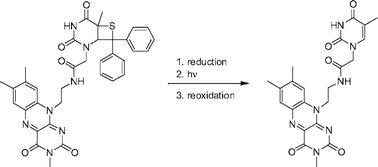Model compounds for (6–4) photolyases: a comparative flavin induced cleavage study of oxetanes and thietanes†
Abstract
Thietanes were used in the past as mimics for an unstable

* Corresponding authors
a
Department of Chemistry, Ludwig-Maximilians-University Munich, Butenandtstr. 5-13, Munich, Germany
E-mail:
Thomas.Carell@cup.uni-muenchen.de
b Department of Chemistry, Philipps-University Marburg, Hans-Meerwein-Str., Marburg, Germany
Thietanes were used in the past as mimics for an unstable

 Please wait while we load your content...
Something went wrong. Try again?
Please wait while we load your content...
Something went wrong. Try again?
M. G. Friedel, M. K. Cichon and T. Carell, Org. Biomol. Chem., 2005, 3, 1937 DOI: 10.1039/B503205A
To request permission to reproduce material from this article, please go to the Copyright Clearance Center request page.
If you are an author contributing to an RSC publication, you do not need to request permission provided correct acknowledgement is given.
If you are the author of this article, you do not need to request permission to reproduce figures and diagrams provided correct acknowledgement is given. If you want to reproduce the whole article in a third-party publication (excluding your thesis/dissertation for which permission is not required) please go to the Copyright Clearance Center request page.
Read more about how to correctly acknowledge RSC content.
 Fetching data from CrossRef.
Fetching data from CrossRef.
This may take some time to load.
Loading related content
